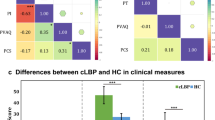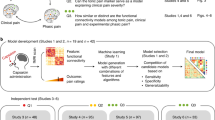Abstract
The brain plays a prominent role in the generation and modulation of pain. It contains powerful endogenous pain modulatory systems that can be engaged in a beneficial way by therapeutical intervention. In contrast, pain chronification is associated with maladaptive structural and functional changes that may shift the balance of the modulatory systems. Although pain from myofascial trigger points (MTrPs) is highly prevalent, little is known about its brain manifestations and modulation. Recent neuroimaging data suggest that hyperalgesia from MTrPs is processed in similar regions as hyperalgesia from other pain conditions. However, abnormal hippocampal hypoactivity suggests that dysfunctional stress responses may play an important role in the generation and maintenance of hyperalgesia from MTrPs. Other data suggest that short-term pain relief obtained with intramuscular electrostimulation within an MTrP is partially due to descending pain inhibitory mechanisms.
Similar content being viewed by others
References and Recommended Reading
Mense S: Mechanisms of transition from acute to chronic muscle pain [in German]. Orthopade 2004, 33:525–532.
Vlaeyen JW, Linton SJ: Fear-avoidance and its consequences in chronic musculoskeletal pain: a state of the art. Pain 2000, 85:317–332.
Gameiro GH, da Silva Andrade A, Nouer DF, Ferraz de Arruda Veiga MC: How may stressful experiences contribute to the development of temporomandibular disorders? Clin Oral Investig 2006, 10:261–268.
Treaster D, Marras WS, Burr D, et al.: Myofascial trigger point development from visual and postural stressors during computer work. J Electromyogr Kinesiol 2006, 16:115–124.
McEwen BS: Physiology and neurobiology of stress and adaptation: central role of the brain. Physiol Rev 2007, 87:873–904.
Niddam DM, Chan RC, Lee SH, et al.: Central modulation of pain evoked from myofascial trigger point. Clin J Pain 2007, 23:440–448.
Niddam DM, Chan RC, Lee SH, et al.: Central representation of hyperalgesia from myofascial trigger point. Neuroimage 2008, 39:1299–1306.
Kuan TS, Hsieh YL, Chen SM, et al.: The myofascial trigger point region: correlation between the degree of irritability and the prevalence of endplate noise. Am J Phys Med Rehabil 2007, 86:183–189.
Gerwin RD, Dommerholt J, Shah JP: An expansion of Simons’ integrated hypothesis of trigger point formation. Curr Pain Headache Rep 2004, 8:468–475.
Gerwin RD, Shannon S, Hong CZ, et al.: Interrater reliability in myofascial trigger point examination. Pain 1997, 69:65–73.
Simons DG, Travell JG, Simons L: Myofascial Pain and Dysfunction: The Trigger Point Manual. Baltimore: Williams & Wilkin; 1999.
Shah JP, Gilliams EA: Uncovering the biochemical milieu of myofascial trigger points using in vivo microdialysis: an application of muscle pain concepts to myofascial pain syndrome. J Bodyw Mov Ther 2008, 12:371–384.
Johnson M, Martinson M: Efficacy of electrical nerve stimulation for chronic musculoskeletal pain: a meta-analysis of randomized controlled trials. Pain 2007, 130:157–165.
Melzack R, Wall PD: Pain mechanisms: a new theory. Science 1965, 150:971–979.
Radhakrishnan R, Sluka KA: Deep tissue afferents, but not cutaneous afferents, mediate transcutaneous electrical nerve stimulation-induced antihyperalgesia. J Pain 2005, 6:673–680.
Chu J, Neuhauser DV, Schwartz I, Aye HH: The efficacy of automated/electrical twitch obtaining intramuscular stimulation (atoims/etoims) for chronic pain control: evaluation with statistical process control methods. Electromyogr Clin Neurophysiol 2002, 42:393–401.
Chu J, Takehara I, Li TC, Schwartz I: Electrical twitch obtaining intramuscular stimulation (ETOIMS) for myofascial pain syndrome in a football player. Br J Sports Med 2004, 38:E25.
Chu J, Yuen KF, Wang BH, et al.: Electrical twitch-obtaining intramuscular stimulation in lower back pain: a pilot study. Am J Phys Med Rehabil 2004, 83:104–111.
Apkarian AV, Bushnell MC, Treede RD, Zubieta JK: Human brain mechanisms of pain perception and regulation in health and disease. Eur J Pain 2005, 9:463–484.
Peyron R, Laurent B, Garcia-Larrea L: Functional imaging of brain responses to pain. A review and meta-analysis (2000). Neurophysiol Clin 2000, 30:263–288.
Tracey I, Mantyh PW: The cerebral signature for pain perception and its modulation. Neuron 2007, 55:377–391.
Mountz JM, Bradley LA, Modell JG, et al.: Fibromyalgia in women. Abnormalities of regional cerebral blood flow in the thalamus and the caudate nucleus are associated with low pain threshold levels. Arthritis Rheum 1995, 38:926–938.
Di Piero V, Jones AK, Iannotti F, et al.: Chronic pain: a PET study of the central effects of percutaneous high cervical cordotomy. Pain 1991, 46:9–12.
Hsieh JC, Belfrage M, Stone-Elander S, et al.: Central representation of chronic ongoing neuropathic pain studied by positron emission tomography. Pain 1995, 63:225–236.
Iadarola MJ, Max MB, Berman KF, et al.: Unilateral decrease in thalamic activity observed with positron emission tomography in patients with chronic neuropathic pain. Pain 1995, 63:55–64.
Tu CH, Niddam DM, Chao HT, et al.: Abnormal cerebral metabolism during menstrual pain in primary dysmenorrhea. Neuroimage 2009, 47:28–35.
Kulkarni B, Bentley DE, Elliott R, et al.: Arthritic pain is processed in brain areas concerned with emotions and fear. Arthritis Rheum 2007, 56:1345–1354.
Kupers RC, Svensson P, Jensen TS: Central representation of muscle pain and mechanical hyperesthesia in the orofacial region: a positron emission tomography study. Pain 2004, 108:284–293.
Petrovic P, Ingvar M, Stone-Elander S, et al.: A PET activation study of dynamic mechanical allodynia in patients with mononeuropathy. Pain 1999, 83:459–470.
Ploghaus A, Narain C, Beckmann CF, et al.: Exacerbation of pain by anxiety is associated with activity in a hippocampal network. J Neurosci 2001, 21:9896–9903.
Fairhurst M, Wiech K, Dunckley P, Tracey I: Anticipatory brainstem activity predicts neural processing of pain in humans. Pain 2007, 128:101–110.
Stoeter P, Bauermann T, Nickel R, et al.: Cerebral activation in patients with somatoform pain disorder exposed to pain and stress: an fMRI study. Neuroimage 2007, 36:418–430.
Geuze E, Westenberg HG, Jochims A, et al.: Altered pain processing in veterans with posttraumatic stress disorder. Arch Gen Psychiatry 2007, 64:76–85.
Yoshihara T, Shigeta K, Hasegawa H, et al.: Neuroendocrine responses to psychological stress in patients with myofascial pain. J Orofac Pain 2005, 19:202–208.
Maekawa K, Clark GT, Kuboki T: Intramuscular hypoperfusion, adrenergic receptors, and chronic muscle pain. J Pain 2002, 3:251–260.
Chen JT, Chen SM, Kuan TS, et al.: Phentolamine effect on the spontaneous electrical activity of active loci in a myofascial trigger spot of rabbit skeletal muscle. Arch Phys Med Rehabil 1998, 79:790–794.
Roberts WJ, Elardo SM: Sympathetic activation of A-delta nociceptors. Somatosens Res 1985, 3:33–44.
Feldman S, Conforti N: Participation of the dorsal hippocampus in the glucocorticoid feedback effect on adrenocortical activity. Neuroendocrinology 1980, 30:52–55.
Fendler K, Karmos G, Telegdy G: The effect of hippocampal lesion on pituitary-adrenal function. Acta Physiol Acad Sci Hung 1961, 20:293–297.
McKenna JE, Melzack R: Blocking NMDA receptors in the hippocampal dentate gyrus with AP5 produces analgesia in the formalin pain test. Exp Neurol 2001, 172:92–99.
Thierry AM, Tassin JP, Blanc G, Glowinski J: Selective activation of mesocortical DA system by stress. Nature 1976, 263:242–244.
Floresco SB, Todd CL, Grace AA: Glutamatergic afferents from the hippocampus to the nucleus accumbens regulate activity of ventral tegmental area dopamine neurons. J Neurosci 2001, 21:4915–4922.
Halgren E, Walter RD, Cherlow DG, Crandall PH: Mental phenomena evoked by electrical stimulation of the human hippocampal formation and amygdala. Brain 1978, 101:83–117.
Prado WA, Roberts MH: An assessment of the antinociceptive and aversive effects of stimulating identified sites in the rat brain. Brain Res 1985, 340:219–228.
Bodnar RJ, Kelly DD, Brutus M, Glusman M: Stress-induced analgesia: neural and hormonal determinants. Neurosci Biobehav Rev 1980, 4:87–100.
Wood PB: Mesolimbic dopaminergic mechanisms and pain control. Pain 2006, 120:230–234.
Emad Y, Ragab Y, Zeinhom F, et al.: Hippocampus dysfunction may explain symptoms of fibromyalgia syndrome. A study with single-voxel magnetic resonance spectroscopy. J Rheumatol 2008, 35:1371–1377.
Duric V, McCarson KE: Persistent pain produces stress-like alterations in hippocampal neurogenesis and gene expression. J Pain 2006, 7:544–555.
Lutz J, Jager L, de Quervain D, et al.: White and gray matter abnormalities in the brain of patients with fibromyalgia: a diffusion-tensor and volumetric imaging study. Arthritis Rheum 2008, 58:3960–3969.
He LF: Involvement of endogenous opioid peptides in acupuncture analgesia. Pain 1987, 31:99–121.
Kalra A, Urban MO, Sluka KA: Blockade of opioid receptors in rostral ventral medulla prevents antihyperalgesia produced by transcutaneous electrical nerve stimulation (TENS). J Pharmacol Exp Ther 2001, 298:257–263.
Millan MJ: Descending control of pain. Prog Neurobiol 2002, 66:355–474.
Zubieta JK, Heitzeg MM, Smith YR, et al.: COMT val158met genotype affects mu-opioid neurotransmitter responses to a pain stressor. Science 2003, 299:1240–1243.
Zubieta JK, Bueller JA, Jackson LR, et al.: Placebo effects mediated by endogenous opioid activity on mu-opioid receptors. J Neurosci 2005, 25:7754–7762.
Author information
Authors and Affiliations
Corresponding author
Rights and permissions
About this article
Cite this article
Niddam, D.M. Brain manifestation and modulation of pain from myofascial trigger points. Current Science Inc 13, 370–375 (2009). https://doi.org/10.1007/s11916-009-0060-7
Published:
Issue Date:
DOI: https://doi.org/10.1007/s11916-009-0060-7




